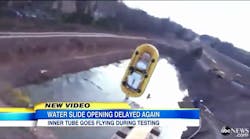Sincerely Stefanie: Schlitterbahn Waterslide Death Demonstrates Slippery Slope to Safety
Thrill seekers flock to amusement parks every year looking for the fastest, tallest, craziest new attraction to satiate their hunger for overcoming danger. In the United States, this translates to a $55.4 billion industry.
Amusement park rider safety is much like worker safety; there is a fine line between profits and injury risk as demonstrated with the recent death at Schlitterbahn Water Park in Kansas City, Kans.
Schlitterbahn Kansas is home to Verruckt, the world's tallest waterslide, an attraction reaching heights above Niagara Falls. Safety hazards or “glitches” supposedly worked out prior to the ride’s opening in 2014 did not prevent the August 7 death of a 10-year-old boy.
Whether it was rider error or operator oversight, the circumstances revolving around this incident only drive the notion that the Verruckt waterslide should never have opened to the public.
Based on reports, many visitors who took the plunge on the slide reported the ride’s raft going airborne or safety restraints, which were Velcro, not working properly during their voyage. Whether they notified employees or whether those employees failed to shut down the ride isn’t known.
News outlets quoted ride co-owner Jeff Henry describing issues with the ride design and operation, and, most notably, that he chose Kansas due to the lack of regulations involved with building such an extreme ride.
Henry even told USA Today, “Schlitterbahn is a family water park, but this isn’t a family ride. It’s for the thrill seekers of the world, people into extreme adventure.”
After testing, he announced the ride downgraded from dangerous to a “safe dangerous.” Verruckt opened for business in July 2014 after months of delays.
Given this oxymoron assigned by the park’s owner, it’s no surprise an accident such as this occurred based on the number of uncertainties. To make matters worse, a 14-and-up age limit was retracted shortly after the ride opened.
At what point does safety take 100 percent precedent over the almighty dollar? Despite meeting weight and height requirements, why was a 10-year-old child allowed on an attraction clearly not meant for kids?
Could it have been a classic case of factors resulting in a “freak accident?” Sure, but it also could be the ride’s "safe dangerous" design contributed in some way directly to the child’s death. The fact remains mathematical calculations used in building the Verruckt waterslide were based on rollercoaster construction and did not factor in the water aspect of the attraction because that data was unavailable.
If the calculations were based on more extreme rides, why was Velcro sufficient enough to hold someone back from flying off the raft?
Even without the results of the state-required investigation, the waterslide shouldn’t have been open to the public if there was that much room for a rider to commit a safety error resulting in any type of serious injury. Kansas legislators should have stepped in and stopped the Verruckt project after Schlitterbahn had to spend another $1 million rebuilding parts of it due to safety concerns.
To make matters worse, the ride has not been inspected since it's initial opening, news reports found. This shows a serious lack of oversight for amusement park visitor safety on the part of state legislators.
What is comes down to is the margin of error for Verruckt was simply too much for anyone to accurately anticipate.
Whether at an amusement park or occupational health and safety, no injury or life is worth risking for the bottom line.
As we are reminded in Jurassic Park, even though it is a fictional amusement park, mathematical calculations and planning only go so far before a catastrophic event occurs.
"Yeah, yeah, but your scientists were so preoccupied with whether or not they could that they didn't stop to think if they should," said Dr. Ian Malcolm in the movie.
Maybe Schlitterbahn should have revisited the film before making plans for the world's tallest waterslide failure.
